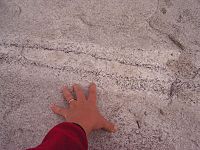
Photo from wikipedia
Abstract Numerous limestone–hosted vein–type Au deposits (12 million tonnes at 5.0 g/t Au) are located peripheral to Cu–Au skarn deposits around the Late Jurassic granodiorite intrusions in the Fengshan area,… Click to show full abstract
Abstract Numerous limestone–hosted vein–type Au deposits (12 million tonnes at 5.0 g/t Au) are located peripheral to Cu–Au skarn deposits around the Late Jurassic granodiorite intrusions in the Fengshan area, Middle–Lower Yangtze River metallogenic belt, Eastern China. Both the Cu–Au skarn and distal vein–type Au deposits have a complex mineral assemblage, consisting of base metal sulfides, sulfosalts and Au–Ag–(Tl) telluride minerals. In the Cu–Au skarn deposits, grains of electrum, Au–Ag tellurides (hessite and petzite) coexist with Bi–Te minerals (native bismuth, tetradymite, Phase C, and aikinite), sulfides (chalcopyrite, sphalerite, and galena), occurring as grain aggregates or veinlets. In the distal vein–type Au deposits, fine–grained Au–Ag–Tl tellurides (calaverite, petzite, hessite, and Tl–bearing Au telluride) occur as ore minerals in assemblages of sulfides, and carbonate minerals. The mineralogical Bi–Te signature characterizes the skarn assemblages, while the Te–Tl signature is typical of the distal vein–type Au mineralization. Textural relations and mineral assemblages allow the recognition of five generations of hydrothermal carbonate: (1) Cu sulfides and tellurides–bearing calcite assemblages; (2) sphalerite, galena and tellurides–bearing dolomite assemblages; (3) sericite, quartz and tellurides–bearing carbonate veinlets; (4) realgar and fluorite–bearing carbonate veinlets; (5) pure calcite veinlets. Electron microprobe analysis indicates that the tellurides–bearing, ore–related carbonate contains variable Mn content (up to 80 mol.% MnCO3). The C–O isotope compositions of carbonate from the Cu–Au skarn mineralization, to the carbonate–replacement Pb–Zn and distal vein–type Au mineralization, and to the post–ore, realgar–bearing veinlets in the country rocks display a tendency towards heavier isotopic compositions with time, which could be best interpreted as the effect of fluid–rock interaction between magmatic fluid and the Triassic carbonate host rocks. New S isotope data on sulfate minerals (anhydrite, gypsum, and celestite), and C–O isotopic data suggest a common magmatic fluid source for both skarn and distal vein–type mineralization.
Journal Title: Ore Geology Reviews
Year Published: 2020
Link to full text (if available)
Share on Social Media: Sign Up to like & get
recommendations!